West Indies Birds
Sometimes with binoculars, sometimes with just the naked eye, we're
always on the lookout for birds! We're dog-earing the pages of
A Guide to the Birds of the West Indies
by Herbert Raffaele, James Wiley and others. The
majority of birds of the Northern Caribbean are migratory, and are also known in
either North or South America. It's fun to see familiar species, but also fun to
learn the new ones. We wish we had more photos, but the older digital camera
we had when we came through the West Indies didn't
have nearly enough zoom, and there's a time delay from pressing the button to
getting the shot which usually means the bird is gone!
Living in a huge salt-water lagoon means we get to see lots of bird life.
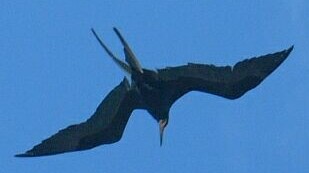 Magnificent Frigatebirds are amazing flyers |
Overhead fly the pre-historic looking Magnificent Frigatebirds. They have bent back wings, spanning over 6 feet, and are superb fishers. The males appear all black, but in breeding season they expand a bright red throat pouch. The females are black overall, with a white breast. These birds never land on the water, but fly constantly when not on their nesting areas, sometimes remaining almost motionless in the air. They are superb fliers as well as fish thieves, diving at each other to snatch the catch from the beak of another frigate bird or a pelican or gull. They are silent, except for guttural noises in breeding season. They are visible over the boat all day long.
Speaking of gulls, there aren't actually that many. At least not like up in Puget Sound were they seem to be everywhere. There are about 4 species down in the islands, but we haven't identified any of them. Naughty us. (See St. Lucia, below)
Royal Terns with their bright orange beaks and black heads on white bodies, perch on wooden pilings like wind vanes. We pass them daily in our dinghy on our way to and from the marine chandleries.
One friend from the Northwest is very common, and that's the Great Blue Heron. The herons stand motionless on the edges of the lagoon, poised to capture their supper.
In the necklace of mangroves that border parts of the lagoon, Snowy Egrets perch and rasp out their guttural guarrr.
Other herons I've seen on the borders of the lagoon are the Tricolored Heron (like the Great Blue, but with a white breast) and the smaller cousin, the Green Heron, with its shorter neck, dark brown and green neck and back, and orange legs.
In the fields by the St. Martin roads where the cattle graze, the Cattle Egrets abound, their white plumage brilliant against the dusty green of the thorn-tree and cactus strewn hills.
Ashore, the tiny (6"-7") Common Ground Dove struts about, often with its tail in the air like a wren.
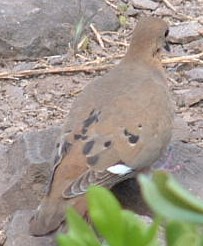 |
The Zenaida Dove is the most commonly seen dove on roof-tops and low brush. Its call is almost indistinguishable from that of the Mourning Dove, and it looks similar, but with a white band on the trailing edge of the secondaries, and a patch of light violet on the neck. |
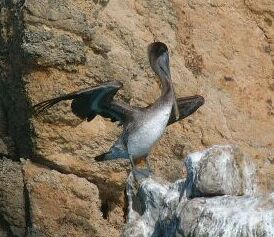 Brown Pelican drying his wings |
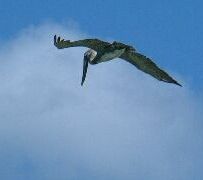 Pelicans are powerful, but awkward looking flyers |
Although the Brown Pelican is common throughout the Greater Antilles (Hispaniola, Puerto Rico, and east to St. Martin), we have seen it most often, and in profusion, on the red and yellow sandstone shores of Anguilla, just a few miles west of St. Martin. A favorite anchorage, Crocus Bay, has a headland called Pelican Point. Here, small flocks of these brown and white-headed birds congregate to feed on the millions of mullet that team just below the surface. When snorkeling, you can be shocked to find a feathered torpedo bomb plunge suddenly in front of you as the birds dive from 60 or 80 feet straight into the water. They snare the fish in their immense bills, surface to drain the water, then swallow it whole. They often fly in low formation over the waves, seeming to skim the surface. They are entirely silent. Old pelicans die of starvation as they go blind from the life years of diving into the sea with eyes open. They can be quite comical on land, and in the 80s we saw them follow fishermen on the beach, intent on getting hand-outs, whapping the people with their long wings asking for more.
Commonly seen among the pelicans is the lovely brown and white Brown Booby, standing about 30 inches high. They fly low to the water, but are more often solitary then the Brown Pelicans. They are common in Anguilla, some of the offshore islands of St. Martin, and along the coast of Nevis.
On this rain-forested island we met our first common finch-like emberizid, the Lesser Antillean Bullfinch. This small, 6-inch bird is quite bold, hopping about the bushes and edges of the picnic areas looking for hand-outs. The male is black, with a red chin and eyebrow. The female is a duller brownish-olive.
High on the rain-forested hills we saw more Lesser Antillean Bullfinches, and a mini-storm of noisy Antillean Crested Hummingbirds. These small (3.5 inches) birds are black with an iridescent green crest. They make emphatic notes, including a distinct pit-chew, like a ricocheting bullet.
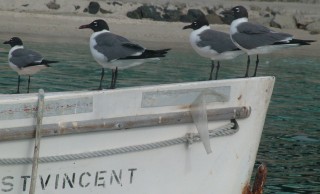
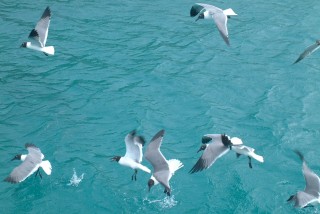 Well, it took all the way south to
St. Lucia before I got close
enough to identify the most common sea gull of the eastern Caribbean, and that's
the black wing tipped, gray back, black headed Laughing Gull. It's a very
small gull, but sure can be raucous when in flocks perched on the rocks on the
shoreline or dive-bombing food scraps!
Well, it took all the way south to
St. Lucia before I got close
enough to identify the most common sea gull of the eastern Caribbean, and that's
the black wing tipped, gray back, black headed Laughing Gull. It's a very
small gull, but sure can be raucous when in flocks perched on the rocks on the
shoreline or dive-bombing food scraps! |
Grenada and the Grenadines
The best part of sailing this far south, and to the east of some of the islands (sailing on the windward side) means we get sightings of the more pelagic birds not seen on shore. We were circled by a 5-foot-wingspan Shearwater, and have seen many White-tailed Tropic birds, their white tail feathers flying behind them.
Top Level: Home | Destinations | Cruising Info | Underwater | Boat Guests | Ocelot | Sue | Jon | Amanda | Chris | Site Map | Make a Comment
|
If our information is useful, you can help by making a donation |
Copyright © 2000‑ Contact: Jon and Sue Hacking -- HackingFamily.com, svOcelot.com. All rights reserved.